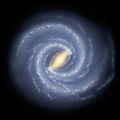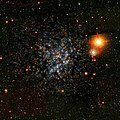List of nearest galaxies
This list of the nearest galaxies to Earth is ordered by increasing distance. Many of the distances are only estimates, and some may be incorrect by 50% or more. The distance ranking in this list should be seen only as a guess. Distances are given in light years (ly).
The nearest galaxies (ranked)
- Milky Way – home galaxy of Earth
- Canis Major dwarf – 25,000 ly (satellite of Milky Way)
- Segue 1 – 75,000 ly (satellite of Milky Way)
- Sag DEG – 70,000 ly (satellite or part of Milky Way)
- Large Magellanic Cloud – 160,000 ly (satellite of Milky Way)
- Small Magellanic Cloud – 190,000 ly (satellite of Milky Way)
- Ursa Minor dwarf – 205,500 ly (satellite of Milky Way)
- Draco dwarf – 248,000 ly (satellite of Milky Way)
- Sculptor dwarf – 254,000 ly (satellite of Milky Way)
- Sextans dwarf – 257,500 ly (satellite of Milky Way)
- Carina dwarf – 283,500 ly (satellite of Milky Way)
- Fornax dwarf – 427,000 ly (satellite of Milky Way)
- Leo II – 701,000 ly
- Leo I – 890,000 ly
- Phoenix dwarf – 1,271,000 ly
- Barnard's galaxy (NGC 6822) – 1,760,000 ly
- NGC185 – 2,021,000 ly (satellite of Andromeda)
- NGC147 – 2,152,000 ly (satellite of Andromeda)
- Andromeda galaxy (M31) – 2,363,000 ly
- Messier 32 (NGS 221) – 2,650,000 ly (satellite of Andromeda)
- M110 (NGC 205) – 2,363,500 ly (satellite of Andromeda)
- Andromeda I – 2,363,500 ly (satellite of Andromeda)
- Andromeda II – 2,363,500 ly (satellite of Andromeda)
- Andromeda III – 2,363,500 ly (satellite of Andromeda)
- LGS 3 – 2,477,500 ly (satellite of Triangulum)
- IC 1613 – 2,494,000 ly
- Triangulum galaxy (M33) – 2,592,000 ly
- Aquarius dwarf – 2,608,000 ly
- Tucana dwarf – 2,836,000 ly
- Wolf-Lundmark-Melotte (WLM) – 3,064,500 ly
List Of Nearest Galaxies Media
Diagram of the nearby local group of galaxies including the Milky Way, the Magellanic Clouds, Andromeda, dwarf galaxies, globular cluster and stellar streams.
Related pages
- Galaxy
- List of galaxies
- Local Group
- Most distant things
- IC 1101: the largest known galaxy, with about 100 trillion stars.[1][2]
References
- ↑ https://arxiv.org/PS_cache/astro-ph/pdf/0209/0209205v2.pdf
- ↑ Uson, Juan M.; et al. (1990). "The central galaxy in Abell 2029 – an old supergiant". Science. 250 (4980): 539–540. Bibcode:1990Sci...250..539U. doi:10.1126/science.250.4980.539. PMID 17751483. S2CID 23362384.









